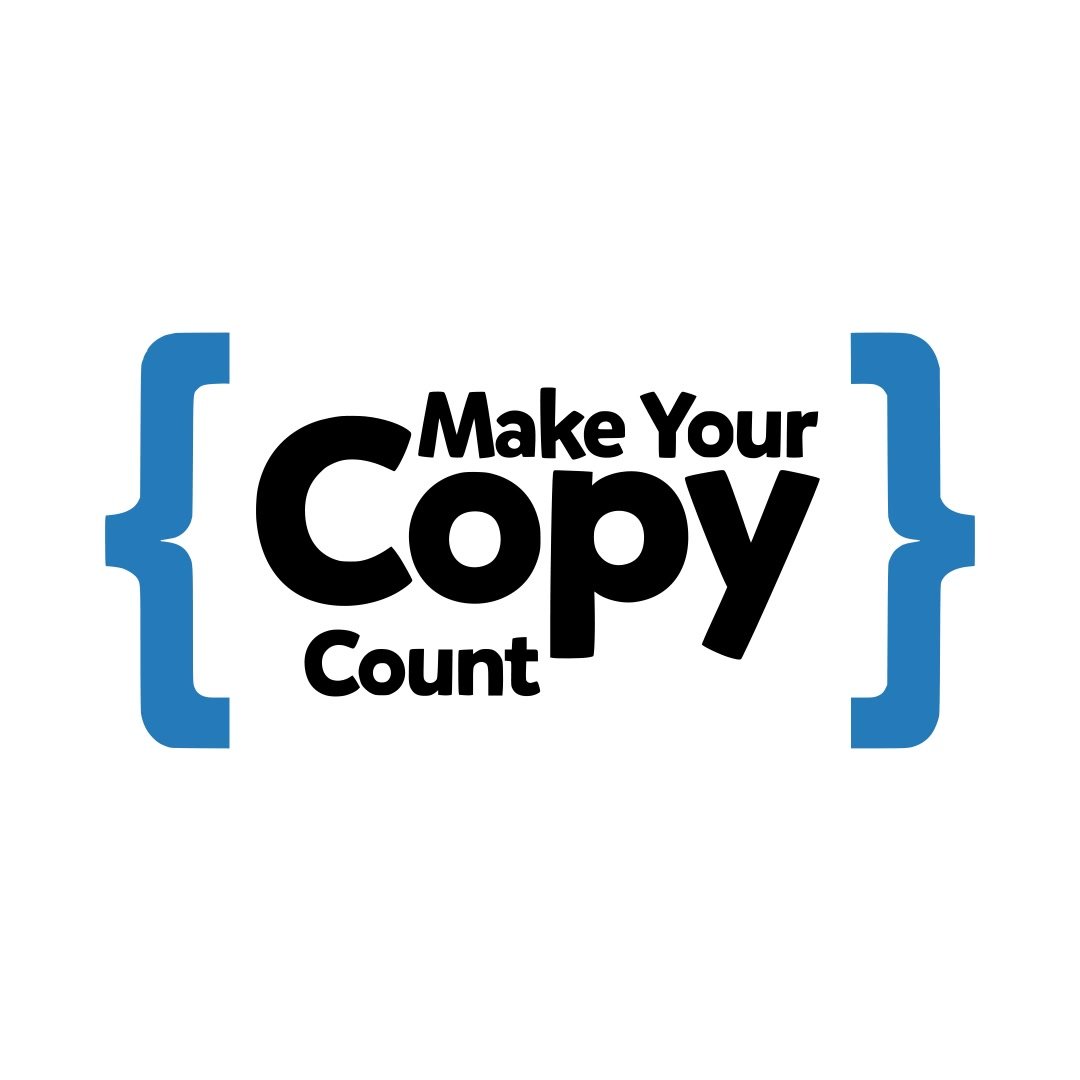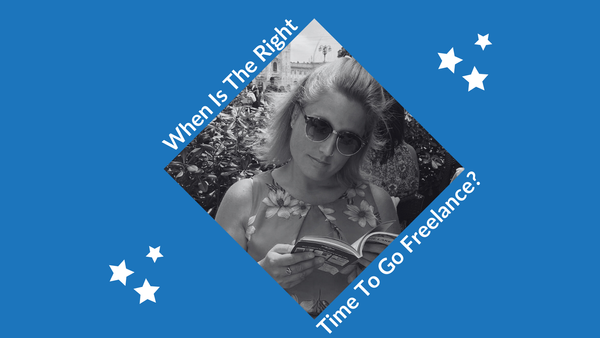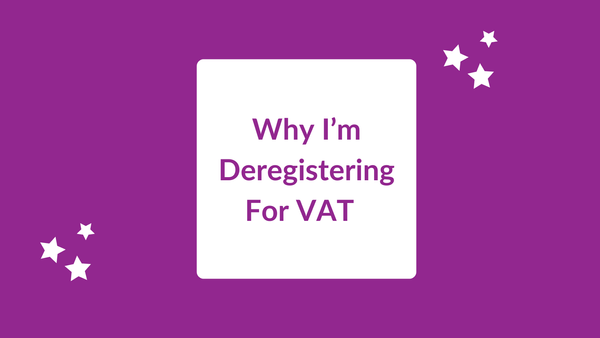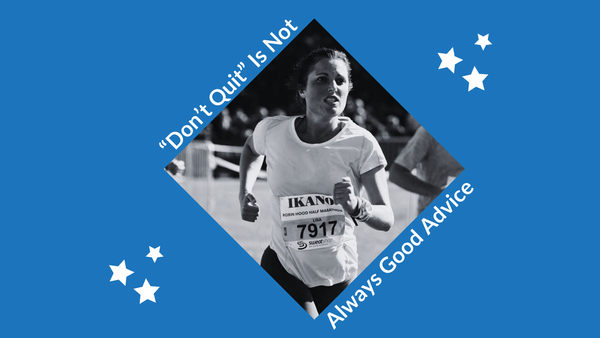Surviving 11 Years In Business
In April 2014, I hit send on my first freelance project. And I sent my first invoice. And I had no idea where my business was heading. Or that I'd be writing about it eleven years later.
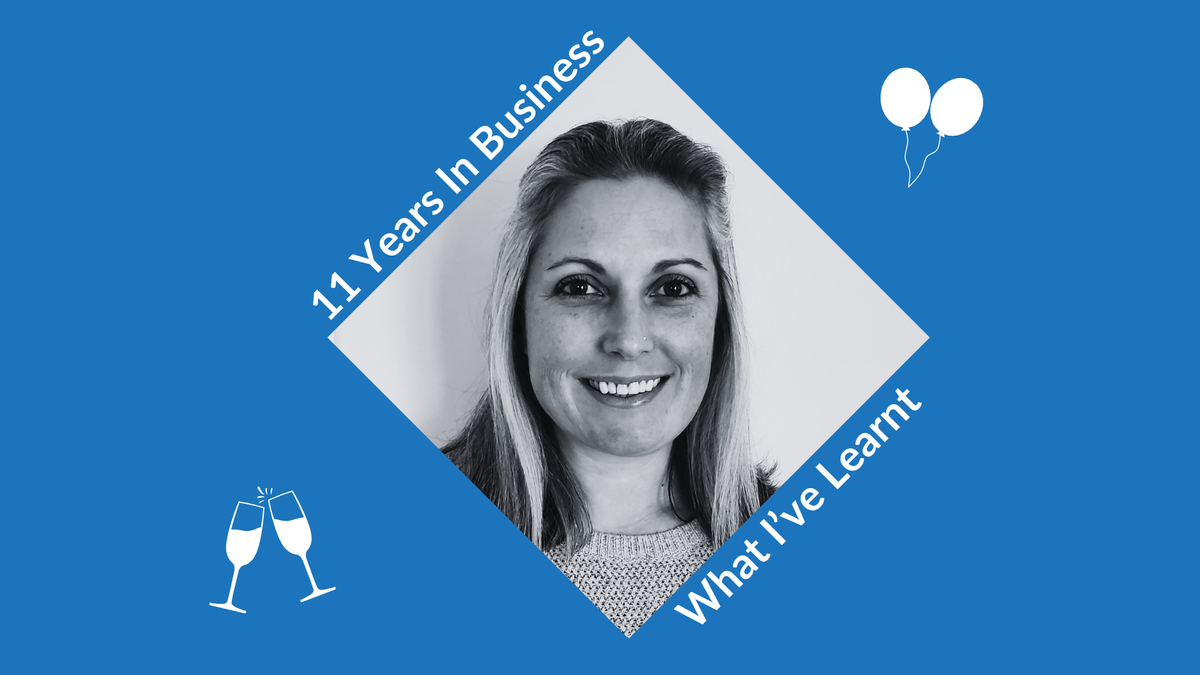
In April 2014, I hit send on my first freelance project.
And I sent my first invoice.
And I had no idea where my business was heading.
Or that I'd be writing about it eleven years later.
But here we are.
It's been over a decade since I started my business and I'm still going. That's something to celebrate, right?
But to make sure this post isn't a completely self-indulgent, self-congratulatory, self-celebration of everything I've achieved, I decided to share some of the low points, mistakes, and failures too.
So if you're interested in my story, you've got a bit of time to kill, or you're curious about whether self-employment ever gets any easier, read on.
A tiny bit of background
I don't want to bore you with my life story, but it makes sense to provide a little bit of background so you have some context. I promise I'll keep it short.
Way back in 2003, I packed my bags and headed off to Mallorca to work a season in Magaluf.
One season turned into nine, working in different countries, and in 2009, I met my husband. For the next few years, we spent our summers working, and our winters travelling the world.

In 2012, we decided to move back to the UK, and settle in Leeds where we've been ever since.
When I moved back to the UK, I had no job lined up and no idea what I was going to do.
I'd always loved writing so I decided to enrol on a freelance feature writing course. Meanwhile, I got a job managing business centres.
After completing my course, I wasn't sure about my next step, so I decided to start a blog. And while researching how to start a blog, I came across a copywriting course.
I had never heard of copywriting, but it seemed to involve selling and writing. I was good at both so I enrolled.
I decided to set up a basic website so I would be business-ready once I’d completed my course. But things moved faster than I expected.
I'd only completed one assignment when I received a message on Twitter inviting me to a networking event.
And that's where I met my first client...
2014: First client

I guess you could say I launched my business by accident - I certainly hadn't expected to start winning clients so quickly.
When I received that invite to a networking event, I panicked.
I wasn't a copywriter. I'd only found out what a copywriter was a couple of months earlier. There was no way I could rock up to a networking event full of business owners and call myself a copywriter - they'd know I was a fraud.
But what if...?
What if I did go? What if I met someone who did need help with their copy? What if it was an opportunity to meet some experienced business owners and get some advice on how to get started?
So I took a chance on myself and accepted the invitation.
And that's how I found myself at a BNI meeting at 7am on a Tuesday morning.
You can't underestimate the role that good timing plays in business. And it played a huge role for me that day.
I got talking to a marketing consultant and he just so happened to be in the process of creating a new website. He was going to work on the copy himself but was willing to give me a chance.
So a few days later, I went to his office with a notebook full of questions and ideas, then spent weekends and evenings working on his copy.
I must have done a good job, because following that project, he referred loads of work to me, and still refers work to me over ten years later.
I often wonder if I'd have ever gotten around to launching my business if I hadn't accepted the invitation to that event.
Year 1 business lessons:
- Putting yourself out of your comfort zone can lead to great outcomes.
- Don't underestimate the relevance of good timing.
- You don't have to wait for the perfect time to launch a new business/product/service - sometimes you just have to go for it and figure the rest out later.

2015: Motivation

2015 was a busy year. I completed my copywriting course, got promoted at work, trained for (and completed) three half marathons, and got married. And as if that wasn't enough, I was taking on more and more copywriting work.
My main copywriting project in 2015 was writing 250-word product descriptions for a branded merchandise company. I got paid £3 per product description, and I could do them at whatever pace suited me. It wasn't the most exciting, interesting, or creative project but it was flexible and easy.
When I was struggling to motivate myself, I'd get the holiday brochure out and open it to the page of the hotel we'd picked for our honeymoon. I'd remind myself that these product descriptions were paying for it. I guess that's the closest I've ever had to a vision board.
I still don't know how I managed to fit all those product descriptions in alongside course assignments, training runs, wedding planning, a full-time job, and other copywriting projects.
But I did it.
I wasn't making millions from freelancing, but I earned enough to pay for my honeymoon and a few other nice treats.
More importantly, I gained the confidence I needed to make the leap into full-time self-employment.
I loved my job, but I wanted to know whether I had what it took to build a business on my own.
So in December 2015, I handed in my notice and the countdown was on to turn 'Lisa Slater Copywriting' into a full-time endeavour.
Year 2 business lessons:
- You can achieve an awful lot when you set your mind to it.
- Having a clear goal (such as paying for a dream honeymoon) can be a great motivator.
- Sometimes you have to take a leap of faith.
2016: Full-time freelancing

March 23rd 2016 was my last day as an employee.
On March 24th, I became full-time self-employed. The first thing I did was go on holiday to give myself a well-earned break before the hard work began.
And once I got back, the hard work did indeed begin.
The pressure was on.
Until now, my freelance business had been a side-earner. It wasn't my main source of income so everything I earned was just a bonus.
Now my business had to earn me a living. It had to pay my share of the mortgage and bills.
I'd saved a little from money to get me through the first couple of months, but I needed to start earning pretty sharpish.
Easier said than done when I didn't have much of a plan.
I'd spent the last year working in various cities around the UK so I hadn't built many connections in Leeds.
I had a couple of clients, but not enough to make a full-time salary. I needed to find more.
I decided networking was the best place to start. After all, it worked really well for me on the first attempt.
So less than two months after leaving my full-time job, I joined a local BNI group and started generating copywriting clients.
Something else I decided to do was dye my hair blue. I worked for myself now. I could do what I wanted. And I fancied trying something different with my hair.
It wasn't supposed to be a branding thing - I just wanted to have a wacky hair colour before I got too old to pull it off. But it turned out to be a good marketing tactic.
I was doing a lot of networking, and people often remembered me and recognised me because my blue hair stood out.
And it was great for when I arranged to meet new prospects - I could just say "look for the lady with blue hair" and they'd find me.
Rollercoaster life
I'd love to say self-employment was easy.
It wasn't.
I smile to myself now when I see newbie freelancers talk about it being a "rollercoaster" because that's exactly how I described it in my first year.
I say "first year" - it was actually my third. But there's a massive difference between freelancing on the side and freelancing for a living.
And there's one particular day that sticks in my mind as a great example of just how much of a rollercoaster it can be.
It was one of "those" days.
I don't know specifically what had upset me, but I was suffering from major self-doubt, feeling completely out of my depth, and wondering if I was really cut out for freelance life.
After a bit of a cry, I pulled myself together and checked my emails.
In my inbox was a message from a lady in New York needing copy for her new website. A couple of messages between us, and she decided she loved what I had to say and was happy to go ahead.
I was over the moon. Six months into self-employment, I was already landing clients around the globe. Check. Me. Out.
That day perfectly represents those early days as a freelancer - you can go from the depths of despair to complete euphoria within minutes (and vice versa).
It's not for the faint-hearted, that's for sure. I certainly wouldn't recommend freelancing as a cure for anxiety - if anything, it can cause more anxiety. You live in a constant state of uncertainty, and if you don't learn how to get used to that uncertainty, it can break you.
But in that first year, the rollercoaster feels exciting.
Despite the horrible lows, everything feels like an opportunity. Every success feels like a huge achievement.
I'd closed some huge deals in my previous job - some worth hundreds of thousands of pounds. And yet, someone agreeing to pay me £90 for a blog post felt equally as exciting.
I earned around £20k in that first year. It was nowhere near my former salary, but at the time, I was over the moon.
I'd made a profit. I'd made enough to pay my share of the mortgage and bills. I felt like a huge success.
That feeling didn't last.
Year 3 business lessons:
- There's a huge difference between freelancing on the side and freelancing for a living.
- Sometimes something you do can have unintended positive consequences (who knew blue hair would be a useful marketing tool?)
- The uncertainty that comes with working for yourself can be both exhilarating and exhausting - the quicker you learn to manage it, the better.
2017: From sole trader to limited company
One of the things that stuck with me from that first year was the idea that being self-employed and being a business owner weren't the same thing.
Being self-employed meant you had created a job for yourself. You could earn a good living doing that job, but your business didn't exist without you.
Being a business owner meant having a business that worked without you. You could take time out of the business and still earn a living.
When I started freelancing, I had no plans or goals for my business. I just wanted to find out whether I could make money working for myself.
But that idea that I wasn't a "proper business" got under my skin. I decided I needed my business to be more than just me.
'Lisa Slater Copywriting' wasn't going to cut it anymore. It was time to get serious.
In January 2017, I made the transition from sole trader to limited company and incorporated Make Your Copy Count Ltd.
I invested in a new website - a "proper" website. I got a fancy new logo and fancy new headed paper, and branded pens and a pop-up banner.
And on April 1st, I started trading under my new company name.
Launching a new service
I'd learnt a lot in my first year, but I also spotted an opportunity.
There were lots of business owners out there who needed copy but didn't have the budget to outsource it or the skills to do it themselves.
But something else was missing too - a general understanding of how marketing and sales worked.
I'd always worked in sales-focused environments. Even when my job wasn't solely sales, I was involved in selling.
But I quickly realised not everyone has sales experience. And I think the biggest mistake new freelancers and business owners make is underestimating how much of working for yourself involves sales and marketing.
It doesn't matter how good you are at the thing you do - you have to be able to convince people to pay you for it.
So I decided to launch two training workshops.
The first was Blogging for Business. Although it focused on blog writing, it was more about content marketing in general. The stuff I taught could be applied to all kinds of content.
I hosted the first workshop for free. I invited a handful of business owners - people I knew would get value from it. In return, they provided feedback that I could use in my marketing.
I hosted five Blogging for Business workshops in 2017. My original plan was to run one a month, but I was probably too optimistic. Filling the places was a slog and sometimes I barely broke even after paying the venue costs.
I also realise now that my pricing was far too low and I shouldn't have had it printed on all my flyers!

An almost big mistake
At the start of the year, I'd planned to launch two courses. I was going to launch both at the same time, but changed my mind when I changed direction with the second course.
Originally, I called it 'Copy for Clients'. The idea was it would be a copywriting course for web designers or marketers who wanted to develop their copywriting skills.
I'd spoken to numerous web designers who built websites for small businesses. Unfortunately, their clients' budgets rarely stretched to copywriting. The web designers knew the copy their clients produced themselves was terrible. But they didn't know how to fix it for them or what to suggest to improve it.
And this is why I thought 'Copy for Clients' would be a good idea. I would teach web designers the basics of copywriting so they could help their clients get better results from their websites.
Fortunately, I changed my mind. 'Copy for Clients' became 'Write to Sell' and was open to anyone who wanted to improve their copywriting skills not just web designers or marketing agencies.
Luckily, I made the change before my website went live, before I had a ridiculous amount of flyers printed, and before I had the workbooks designed.

An obvious (or not so obvious) opportunity
Before launching the first Write to Sell workshop, I was asked by someone in my BNI group whether I'd deliver it to some of his team. He ran a web design agency and wanted a handful of his employees to brush up on their copywriting skills.
This was great for two reasons. Firstly, because it gave me a chance to test the course content. And secondly, because I'd never thought about offering my training as an in-house service.
It seems pretty obvious that I would offer it to full teams rather than simply inviting individuals to pre-scheduled events. But, for whatever reason, it didn't occur to me to offer this service.
It just goes to show that you can miss really obvious opportunities when you're too close to something.
I delivered that first in-house training in August and hosted my first workshop in October with ten people in attendance.
But something else exciting happened too.
A lady who attended one of my Blogging for Business courses worked in prisons as a tutor. She taught the business class and thought my courses would be great for her students.
And so, in November 2017, I spent two days in a local prison delivering a revised version of my workshops to two groups of inmates.
I did try and get into other prisons in the area, but I never managed to connect with the right people. It's a shame as I found it really rewarding and would have loved to do it more.
Many mistakes and lots of learning
Although it might seem like 2017 was a success, there are plenty of things I'd have done differently. It was a huge year for learning and not everything was rosy.
When I launched Make Your Copy Count, I intended to grow my business and build a team. So I did what a lot of people do and tried to make my company sound bigger than it was. All my copy was about "we", "us" and "our team," but it was still just me so it didn't feel right.
(I did eventually grow to a team of three, but now I'm back to just me and my website reflects that.)
I also went all in on my courses. I was so confident they would be successful that I had branding designed for them both, focused my new website around training workshops, got workbooks and flyers and loads of other printed materials made.
I wanted everything perfect before I launched.
What I should have done was test the market, test the content, and then tweak my plan.
If I'd have waited I'd have had a better idea of what to include in the workbooks. I'd have realised I needed to leave more space for notes on certain topics. I'd have realised the order of the content needed changing and I'd have been able to design the workbooks to reflect that.
But it's all part of the learning process. And fortunately, the mistakes I did make weren't irreversible or too costly.
Year 4 business lessons:
- Not all ideas are going to work - make sure you develop the idea fully before rushing into anything.
- Your product or service doesn't have to be perfect in the beginning - test ideas and build on them gradually.
- Sometimes you are too close to your own business to see obvious opportunities.
2018: Getting published

Towards the end of 2017, I wrote a series of blog posts called A-Z of Blogging. Each blog post focused on a different letter of the alphabet - A is for Analytics, B is for Backlinks and so on.
My idea was to share them as standalone blog posts and then make a PDF version with bonus tips for each letter. I'd use the PDF version as a lead magnet.
A client told me how much she was enjoying the blog posts. She suggested I turn them into a book.
I knew a publisher, so I had a chat with him and we agreed terms. I reworked some of the content, added to it, and let the publisher take care of the rest.
A few weeks later my book was live on Amazon and I had a box full of copies sitting in my hallway.

The day my book went live, I was so happy.
When I was a child, I dreamed of being a published author, and now I was one. But if I'm completely honest, it didn't feel the way I expected it to.
I always thought writing a book would be this big labour of love - something I poured blood, sweat and tears into. Something I'd be super proud of.
A-Z of Blogging wasn't that.
I joke now that I wrote that first book by accident. And I kind of did because it never started out as a book.
Don't get me wrong, it's good and I put a lot of time and effort into the content. But it's not the book I want to be known for. I don't really promote it any more - I don't think it's a great book or that it's my best work (although maybe it was at the time).
My second book was much more of an achievement - a much better book - and something I'm far more proud of. But back in 2018, having a book on Amazon felt huge. And it boosted my credibility.
Meanwhile, things were ticking along nicely. Most of my work was still coming through referrals from my BNI group and I took over as president of the group in October 2018.
I was increasing my profits year on year. I was developing my skills. I felt confident calling myself a copywriter. I was even outsourcing some stuff.
But I wasn't achieving my goals.
Expensive lessons
My goal was for my courses to generate the majority of my income, but it just wasn't happening.
'Done for you' copywriting still made up the biggest part of my turnover despite me pushing the courses as much as I could.
And while I enjoyed writing copy, I loved doing the training more.
So I kept plugging away.
I kept pushing the courses.
I spent over £1500 on Google ads and didn't get a single booking.
I spent £800 on some brochures plus another couple of hundred pounds mailing them out. Still nothing.
I paid for SEO services.
I paid to guest blog.
I paid for lots of stuff.
But I still struggled to fill the places.
I probably should have stopped running the courses, but I was so determined to make them work.
Of course, I now know where I was going wrong and what I'd do differently. But back then I was just throwing money at stuff hoping it would pay off.
Another learning curve. And an expensive one at that.
The bright side
I tried to look on the bright side. Building a business takes time and at least I was making money.
I felt like all the hard work would pay off eventually. I was building good reviews. I was making lots of contacts. I was making sales. I had a good website, good branding, a good reputation, nice marketing materials, a professional-looking brand. I'd written a book. I was doing everything right, right?
It would all pay off soon, wouldn't it?
Year 5 business lessons:
- Your experience of something you've always wanted isn't always as you'd expect it to be.
- Just because you want to make something work doesn't mean it will work - no matter how much money you throw at it.
- Be prepared to lose a bit of money testing marketing ideas that don't work - just don't overstretch yourself.
2019: Stuck in a rut

What can I say about 2019?
Not a lot.
It was a frustrating year.
I felt like I was doing everything right and still not getting where I wanted to be.
Everyone else seemed to be smashing it, while I was getting enquiries that went nowhere, prospects that pissed me around, and too many clients that didn't really value me.
I was working long hours on projects I didn't particularly enjoy, and earning nowhere near what I should have been.
BNI was taking up loads of my time and effort and the return on that time and effort was no longer enough to justify my membership.
I felt stuck in a rut. It was two steps forward, one step back. I had fallen out of love with my business.
Safety net
One of the directors from my old company got in touch and offered me some freelance work. It had nothing to do with copywriting, but they offered me good money, so I agreed.
And I smashed it.
The problem was, it created a safety net. I no longer needed to push my business as hard because I could just top up my income doing work for my old employer.
I wanted to make my business work, but I knew I could make more money if I went back into employment.
I felt like I was back to square one.
Go all in on my business or go back to employment.
It was time to make some changes.
After my term as president finished, I left BNI. I needed to focus on my business.
I started working with a mentor too. I was sceptical about it - I'd always seen mentors as a luxury I didn't need. They would just tell me what I already knew, so what was the point?
But I had nothing to lose and something had to change.
That first mentoring session was eye-opening.
Him: "I never see you posting on LinkedIn."
Me: "I stopped posting on there - it wasn't working for me and I got fed up with it."
Him: "But how can you tell other people to be sharing content on there if you aren't doing it yourself?"
He was right.
And so I started using LinkedIn again. But I started using it more effectively than I had in the past.
A couple of weeks later, I went to a networking event and three different people commented on my content. That gave me the boost I needed to keep going with it, and it paid off. Between 2020 and 2025, LinkedIn was my main source of new clients.
I still wasn't completely happy with my business, but at least I headed into 2020 with renewed motivation.
Year 6 business lessons:
- If your main marketing activity is no longer working for you, it's time to try something else (instead of or as well as).
- Mentors are a great investment - a fresh perspective can be just what you need to reinvigorate your business.
- Waiting for things to get easier is a stupid strategy - if you want things to change, you have to be the one to change it.
2020: Turning point

The year started well - I was feeling positive. In January, I delivered training to a marketing team all the way down on the south coast, I was booked to speak at an event at the NEC, and I’d started working with a mentor.
Then lockdown hit.
Luckily I had enough money in my business to keep me going for at least six months. As it turns out, I didn’t need it.
Despite the global pandemic, 2020 turned out to be a good (and very profitable) year for me.
My old company paused the work I was doing for them - we've never picked it back up. It meant I got rid of the safety net. I also lost a few clients which freed up time for me to make some huge changes to my business.
Going online
I'd had a Write to Sell workshop booked in for the week after the first lockdown started, so I delivered it via Zoom instead.
It wasn't as good as doing it in person because attendees didn't interact as much, but it worked.
I ran a couple more online workshops that year, but eventually, decided to pause them indefinitely. I'd given them three years - it was time to try something else.
I had plenty of time on my hands during the first few months of lockdown, so I recorded an online version of Blogging for Business. I put it on Teachable for a year and didn't make a single sale. I later moved it to my own website and immediately got sales (another learning moment).
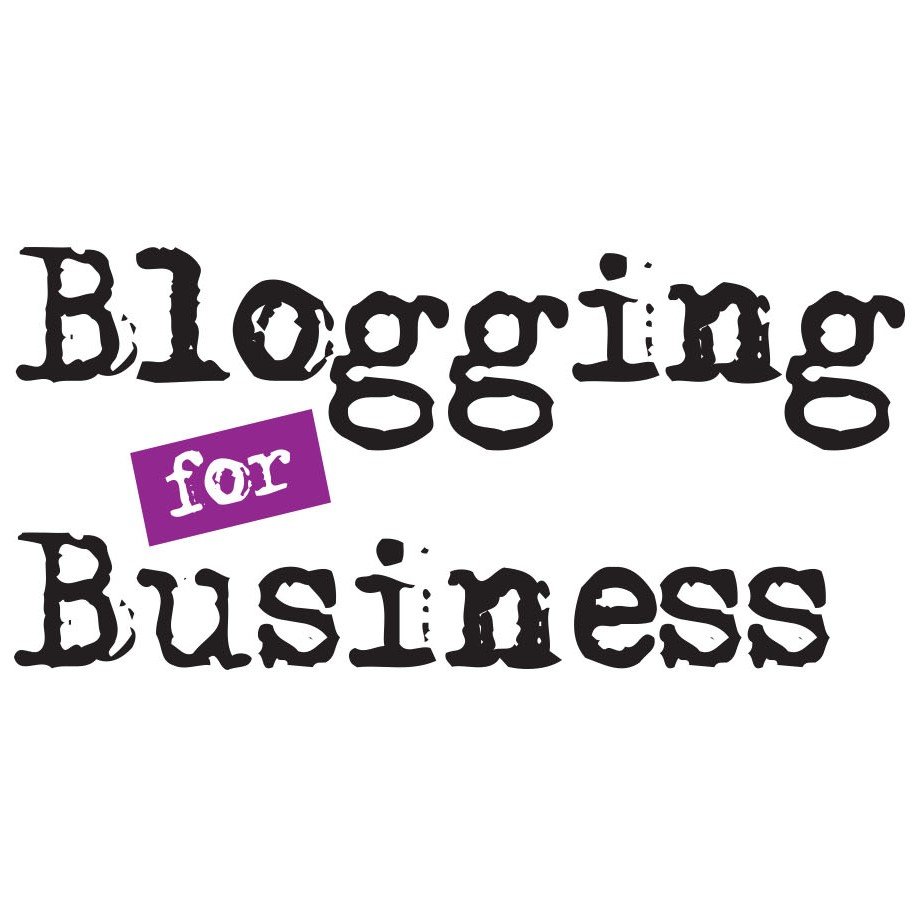
Another thing I did during lockdown was launch my monthly Content Clubs.
This was an idea I'd had for a while but had never done anything with.
I'd noticed that people would come on my blogging course and leave with a head full of ideas and good intentions. Then I'd speak to them a few weeks later only to find out they'd never gotten around to putting the ideas into practice.
Content Club was designed to combat that problem. The idea was we'd meet monthly. Everyone would set their goal for the session, I'd provide a bit of advice and training, then we'd have 45 minutes of writing time.
After the 45 minutes, everyone would share the progress they'd made and we'd discuss any challenges. Then everyone would set themselves homework to do before the next session.


Lockdown was the perfect time to launch Content Club as it was easier for people to commit to a set time each month.
I ran Content Club for 13 months then let it come to a natural end because I was focusing on other things by then. But I loved running them so I always hoped to bring them back one day (spoiler: I've reinvented them for 2025).
Back on track
When lockdown hit, I was worried (like many businesses were). But as it turned out, 2020 ended up being the most profitable year I'd had up until that point.
I had even taken on an employee and a subcontractor to help me with the workload. I had a team.
And I felt back in control of my business.
I was falling back in love with it and finally felt like I was getting somewhere.
Year 7 business lessons:
- Sometimes events outside our control force us to make changes and it's not always a bad thing.
- When you get rid of the clients that take up too much of your time and energy, you free up time to focus on what you really want.
- Self-employment is so much better when you feel in control of your business and aren't letting it run you.
2021: A new direction

I'll be honest, 2020 and 2021 kind of merged into one - I'm sure most people felt that way given the constant hokey-cokey of lockdowns.
But 2021 was another positive year for me.
I don't know quite when it happened but at some point between 2020 and 2021, I realised that I didn't want a "proper business".
I realised I just wanted to do the thing I loved for people I liked and earn good money doing it.
For so long, I had been working towards someone else's idea of what successful looked like. It was the reason I had struggled to make my business work. I'd let the idea that I wasn't a proper business distract me from what I wanted from my business (and life).
I was holding on to the copywriting work because I thought I could build a team of copywriters - that was how I could scale my business and make it work without me.
But what I really wanted to do was the other stuff - the training and mentoring. I loved doing that. I didn't want to build and manage a team of copywriters.
So what I was trying to do - scale my business - didn't align with what I wanted to do.
Time for some major changes
Business was booming, and so was the freelance market.
I was seeing copywriters spring up everywhere, boasting about how much work they were getting, how much money they were making, and so on.
Great for them, I thought, but I knew it wouldn't last. The effects of Brexit and the pandemic would kick in at some point.
Instead of simply riding the wave like I saw other people doing, I invested in my business and put the foundations in place for the future.
I started working with a new business mentor. The first mentor gave me the kick up the arse I needed to make a change, but the second helped me take things to the next level. He helped me figure out what I really wanted and taught me how to build a business that worked on my terms.
I stopped promoting 'done for you' copywriting services. I knew that I'd never make the majority of my income from training and consulting if I didn't make it the main focus of my business.
I launched 'Borrow my Brain' - my 90-minute marketing consultations and I had 30 bookings in the first year.
I spent a few thousand pounds on video content (but this time I planned my marketing strategy properly).
I got a new website - one I had more control over - and I rewrote all the copy (making it about me, not we).
I created a lead magnet - my 'Get Copy Confident' email series.
I started an email list and started sending daily emails (I gradually cut down to four days a week as seven was tough to manage).
I'd always toyed with the idea of starting an email list, but never made it a priority. This was mainly because email marketing wasn't my preferred way of being marketed to. I'd often subscribe to emails and then end up deleting most of them without reading them before unsubscribing a few days later.
But I managed to overcome my preconceptions about email marketing and gave it a go. And guess what? I got (and still get) business from it.
Just because you don't like a particular way of doing things, doesn't mean your ideal clients won't like it. Get over your bias and give things a try - you might be surprised.
From mentee to mentor
After working with my mentor for a few months, I felt so much happier with my business, and so much happier in my life.
I realised it was possible to make good money doing the thing you love for people who are great to work with. I was doing it. And I wanted to help others do the same.
So towards the end of the year, I launched my marketing mentoring programme. It was a few weeks before I got any serious interest, but in December, I got my first three sign-ups.
Year 8 business lessons:
- If you want to change the direction of your business, you need to let go of the stuff you no longer want to do and stop working to other people's goals.
- When times are good, don't get complacent - that's the time to invest in your personal and business development.
- Just because something isn't your preferred way of being marketed to doesn't mean it won't work.
2022: Happy Ever After

My mentoring programme was originally focused on copywriting and marketing. I wanted to give freelancers and small business owners the skills and confidence to attract and convert more of their ideal clients.
I'd finally figured out how to do it and was in a position to teach others.
But I quickly realised that my mentees were facing a lot of the problems, challenges, and frustrations I'd been facing pre-pandemic.
And I could help with that too.
My business was where I wanted it. I was genuinely happy.
But it hadn't happened overnight. It wasn't like the fairytale stories you see on social media. There are no magic beans.
And that's where the idea for my book - The Freelance Fairytale - came from.
The idea for the book started developing way before I decided it would be a book. But gradually, ideas came together, inspiration hit and I started writing until I had something I'm extremely proud of.
Attract. Nurture. Convert
Around April time, I decided to run a mini-course. The idea was it might be a good way to get people interested in my one-to-one mentoring.
I didn't really have a plan for what the course would cover, but I decided on a format. It would run for five consecutive days. Each morning I'd send a video lesson out and each afternoon, I'd run a group session based on that morning's lesson.
I sent the following email out to my subscribers:

I didn't think I'd get much take-up until I had a clearer idea of what I'd be covering, but I was wrong.
Five people signed up and paid after that first email.
And because five people signed up and paid, I had to come up with some content. So I did.
I didn't fill my 15 places - I filled nine and I was happy with that.
I wanted somewhere I could host the content, so I found a plug-in that I could add to my website.
And as I had paid for this new plug-in, I decided to get my money's worth so I uploaded my online Blogging for Business course. It had failed miserably on Teachable, but there was no cost or risk to relaunching it on my own site. As it turned, out I got a couple of sign-ups almost straight away - bonus.
After that first mini-course, I added another set of dates - I had the content, the platform, and some great reviews to help me promote it. I'd just need to block out time for the live sessions.
I didn't get any take-up the second time, so it never went forward. And then I got distracted with other things so I never did any more with it. Maybe that's another product I'll bring back in the future.
Year 9 business lessons:
- You can make decent money doing the thing you love for people you like - you can have a business that makes you happy and works on your terms.
- Generate interest in your new product or service before you spend loads of time creating it.
- If you have built trust with your email subscribers and past clients, they'll buy from you even if the product is not quite fully formed.
2023: Tougher times

2022 was a fantastic year from a business perspective, but I knew from as far back as 2020 that it was only a matter of time before the bubble burst.
2023 seemed to be the year it burst for a lot of people. Week after week, I'd see more and more freelancers admitting they were struggling.
Fortunately, I had invested in my business while the going was good, so I wasn't hit as hard as some freelancers and small businesses were.
I won't pretend 2023 was a walk in the park, but it wasn't a struggle to make ends meet either.
People weren't throwing money at me, but I still had a steady stream of clients and some nice chunks of cash coming in.
A clear plan (that quickly got abandoned)
I started the year with a clear plan.
I wanted something that followed on from my book. Something that sat between the book and my full mentoring programme.
I came up with the Happy Ever After Hub. I launched it in December 2022 and my plan was to grow the membership throughout 2023.
Unfortunately, the hub never took off. I got a handful of members when it first launched, but then it flopped.
And the money I generated didn't cover the time I was investing in it.
After a year, I had to abandon it.
But I know why it failed.
There are several factors, but the main reason was a change in focus.
Relaunching Write to Sell
At the start of the year, I was contacted by the owner of a marketing agency. He asked if I did copywriting training. I said I did. So in February, I delivered Write to Sell to his team over two days.
I had forgotten how much I loved doing the in-person training. And how good the content was.
So I decided to relaunch Write to Sell.
I wouldn't run the workshops, but I'd offer it as team training. And I'd make an online version.

The hub fell by the wayside because I had a lot to do to get Write to Sell back on track.
I had a big trip booked for May - three weeks in Peru - and I wanted to do the pre-launch while I was away (with the go-live date set for when I got back).
I created a new landing page for my website, wrote the launch emails, scheduled a load of LinkedIn posts promoting the course, and started filming the content.
I launched as planned, which meant I had a little bit of money coming in while I was off exploring Peru.
When I returned, my team training page had started getting traction too and I got a booking to deliver Write to Sell to a marketing team over in the States.
Unfortunately, their budget didn't cover flights, so I delivered it over four days via Zoom instead of in person.
Positives and negatives
I'm over the moon that Write to Sell is back - I love doing copywriting training and I genuinely do think it's the best skill you can develop as a freelancer or small business. But refocusing on Write to Sell meant my hub idea failed.
I slipped back into the bad habit of trying to market too many things at once.
Rather than focus on mentoring (which is the thing I love doing most), I was pushing my courses and my hub and my team training. I was trying to market to too many products and services to too many different audiences.
I had to get myself back on track.
I went back to using my personal LinkedIn profile for promoting my book, my consultations and my mentoring services. I used my LinkedIn company page to promote the copywriting training.
I did go off track a little by starting a newsletter about beer. It was completely unrelated to my business, but after ten years, I felt like I'd earned the right to have a little passion project.
Year 10 business lessons:
- Investing in yourself and your business when times are good pays off when times are tough.
- Changing your plan will mean getting different results to the ones you expected - that can be positive or negative.
- Even after ten years in business, you never have it completely sussed out.
2024: Adapting to the market

I had known for a while that the business name Make Your Copy Count no longer covered the scope of what I offered.
I needed to separate the mentoring side of my business from the copywriting training so I could market both sides of the business more effectively. So 2024 was a year of changes.
I updated the Make Your Copy Count website so it focused on copywriting training and marketing consultations.
I then launched LS Mentoring and built a new website focused on my mentoring services. I also launched a new service: Mentoring Lite.
I was still getting business, but I had seen a drop in enquiries which wasn't surprising given the state of the freelance market in general.
A lot of freelancers, particularly in creative industries, were still struggling and the rise of AI made things even tougher.
More and more freelancers were falling by the wayside and even those who were doing ok didn't have big budgets for mentoring.
Mentoring Lite was my way of making my support more affordable and accessible to struggling freelancers without devaluing or diluting what I do.
It's one-to-one mentoring on a rolling monthly basis so there's no long-term commitment or large upfront investment. It allows clients to spread the cost, making it easier to budget. Plus, they can pause the mentoring for whatever reason, if they need to.
Within weeks of launching Mentoring Lite, I had a new client. After a couple of weeks, she left me a review and it's one of my favourite ever pieces of feedback.
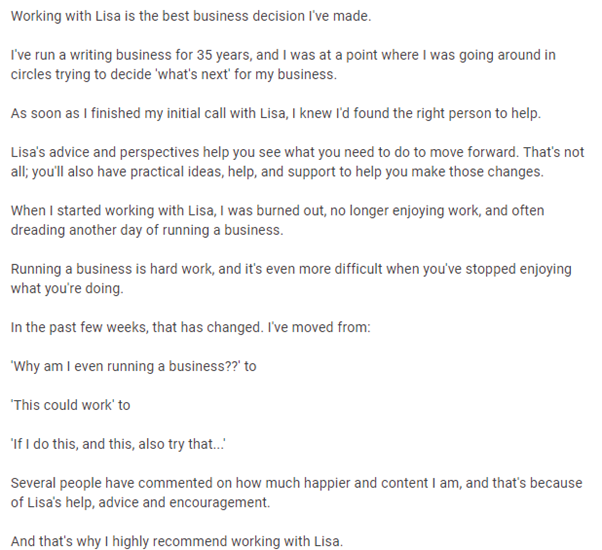
I talk a lot about building a business that makes you happier so the fact that people have noticed she's happier since working with me fills me with joy.
A little side project
As well as launching LS Mentoring, I also turned my beer newsletter into a proper beer blog - New Brew Thursday
After writing the blog for a few months, I decided to test an idea I had. So, in September, I hosted my first New Brew Networking event and I've hosted one a month ever since.
The events are online and free (although I'd like to make money from them in the future). And the idea is simple: buy yourself a beer you've never tried before and then join the event. We introduce ourselves, our businesses and our beers, and then have a friendly chat.
Year 11 business lessons:
- There's always room for improvement.
- The market is constantly changing so it's important to evolve and adapt.
- When you structure your business correctly, you have more time for passion projects.
2025: What's next?
By the end of 2024, I was creating content for two different businesses and a hobby blog, but I was trying to share updates from a single email account. I needed to separate the content and my email list.
I also wanted a place to share content that wasn’t business-related. I wanted to write about things that interested me or were important to me. I tried Medium for a couple of weeks but ran into some problems so I was looking for an alternative.
Substack seemed to be the one most people were talking about, but Beehiiv and Ghost were also getting great feedback. I'd never used any of them and had no idea which would be best for me as they all offered something slightly different.
I decided to try all three. I had three websites with three target audiences and now I’d found three platforms - it seemed like a no-brainer.
But rather than just set them up and quietly get on with it, I decided to share my experiment with the world.
And so, at the start of the year, I launched my 2025 Content Marketing Experiment - an experiment to set up, launch, grow and monetise publications on Beehiiv, Substack and Ghost.
Since I started, I've been sending weekly email updates where I share my thoughts, learnings and results.
I'm absolutely loving it so far. It's given me a renewed motivation and I'm learning new stuff I can share with clients.
Write With Lisa
At the start of March, I launched the free version of Write With Lisa - a publication for anyone who writes whether for money, business or pleasure.

I also introduced an early bird offer for the paid membership which went live on April 1st.
I'm really excited about my new membership. It allows me to offer support to more freelancers at an unbelievably low price of £20 per month.
So that's my focus for the rest of the year - growing my membership.
But, of course, I'll still be offering one-to-one mentoring because I absolutely love helping other freelancers build businesses that work for them just like I built one that works for me.
Here's to happiness
So here I am - 11 years in.
I might not have it all completely sussed out, but I am genuinely happy with where I am now.
I have fantastic clients. I enjoy all the work I do. I have a very relaxed working week and never feel I have to take on more than I want to. And I earn enough to have the lifestyle I want.
My business isn't a hobby - it provides me with a full-time income that covers my mortgage, bills, and other personal expenses. But that doesn't mean I have to be working in it twenty-four-seven.
Don't buy into the myth that you can only have a successful business if you sacrifice your soul. You can have a business that works around you.
And if you need help building that business, get in touch.
If you've read this far, then thank you. I hope you have found some of my ramblings insightful or useful. And please do reach out to me if you're struggling.



